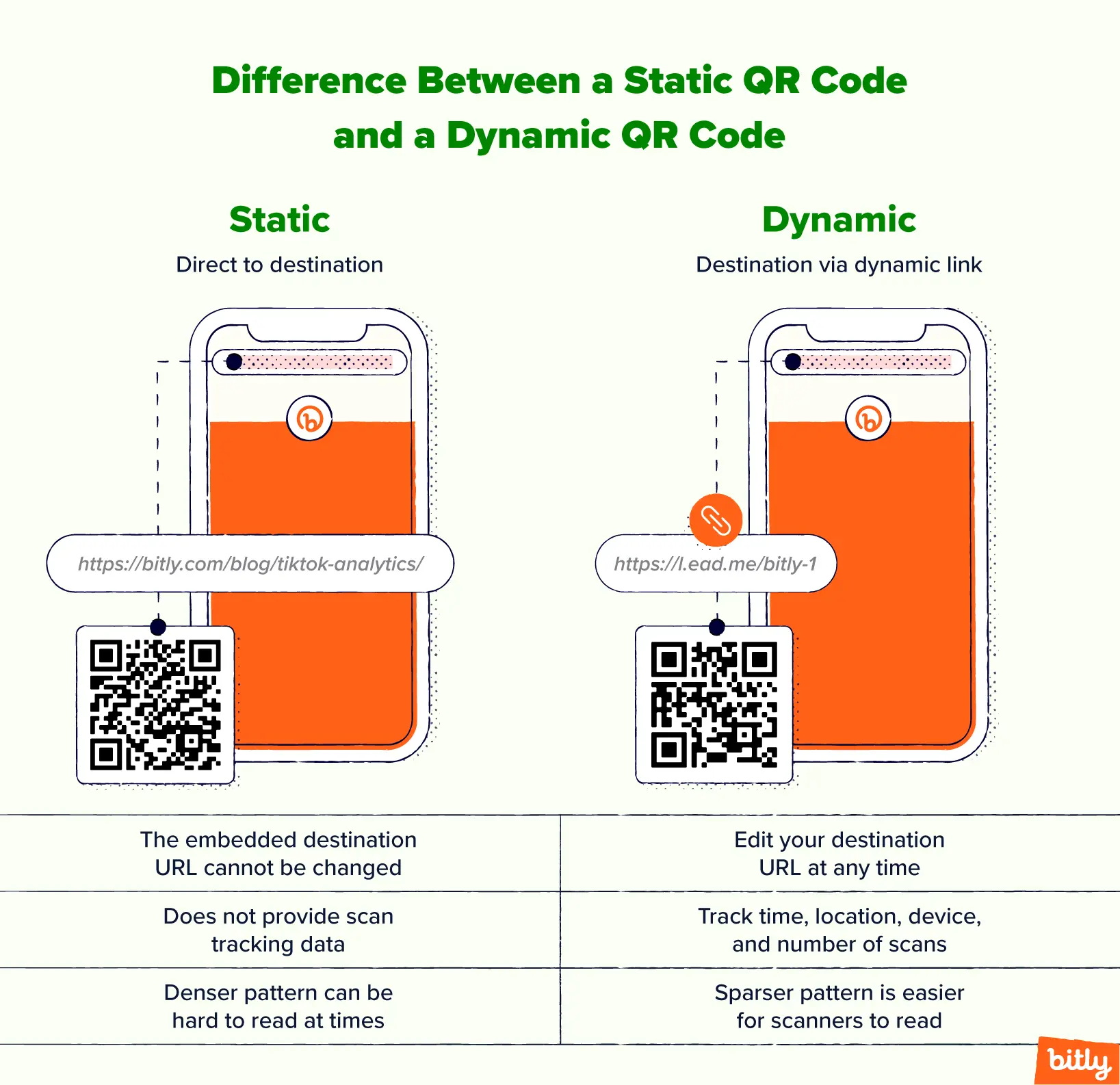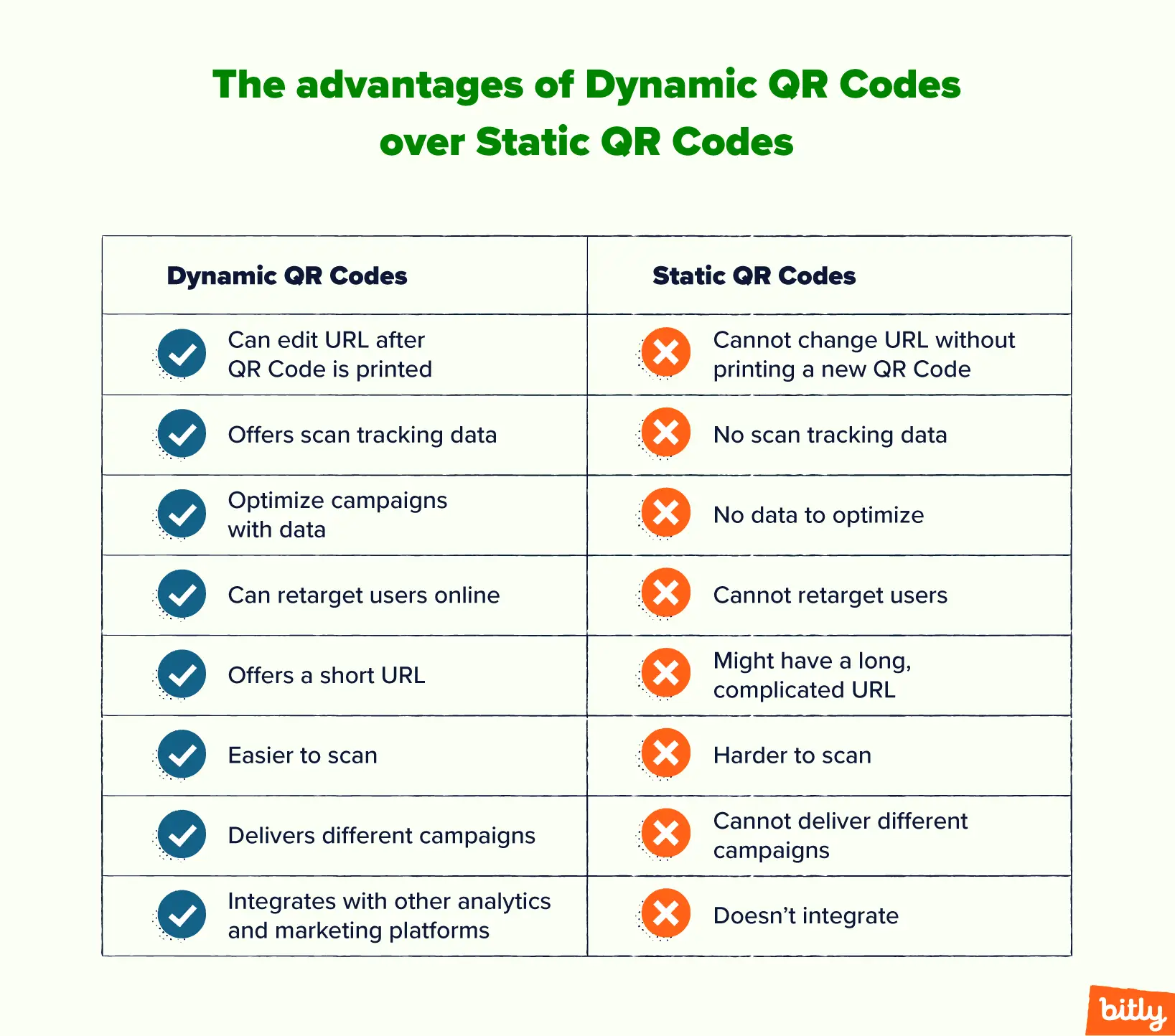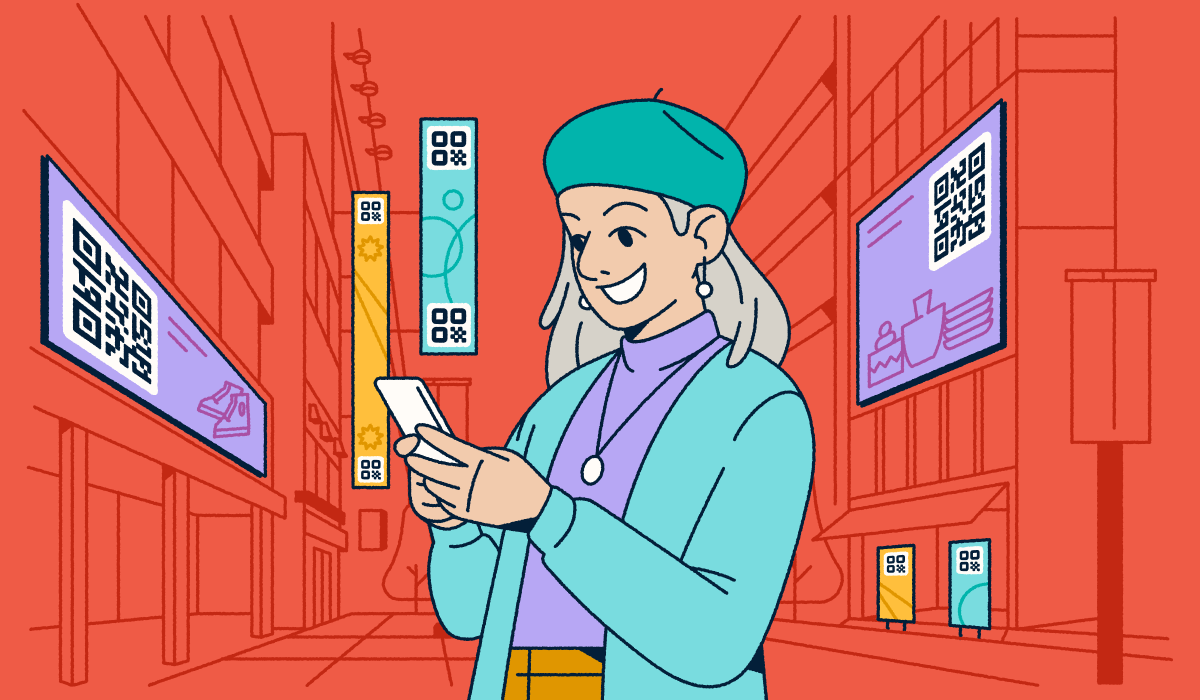A QR Code is a scannable code that redirects users to digital content when scanned with a smartphone. Static QR Codes store fixed information. Once created, the destination URL can’t change. They’re ideal for one-time use cases where the content rarely changes.
Dynamic QR Codes, on the other hand, use a modifiable short URL to redirect users to your latest landing page or marketing campaign, without reprinting any code. For large-scale marketing strategies, Dynamic QR Codes offer scalability, better user experience, and cost efficiency over time, making them ideal for enterprise-level QR Code campaigns.
Note: The brands and examples discussed below were found during our online research for this article.
Do static and Dynamic QR Codes look different?
Visually, static and Dynamic QR Codes can appear similar, but their data storage method affects scanability and user experience—especially in enterprise contexts like retail signage, product packaging, and other marketing materials.

The main difference is that Static QR Codes store all information directly in the code itself, which increases visual density when encoding long URLs or detailed contact information. This can make the code harder to scan quickly, particularly from a distance or when printed on small surfaces.
Dynamic QR Codes, however, use a short URL to store less data in the code, resulting in cleaner designs that scan reliably. This improves how QR Codes work at scale, which is critical when campaigns require consistent, fast scans across thousands of printed materials and locations.
What is a Static QR Code?
A Static QR Code is a fixed, uneditable code that stores all data, such as a long destination URL or contact information, directly within its design. Once generated, that information cannot change, making it unsuitable for large-scale marketing campaigns, performance optimization, or advanced features like retargeting.
In enterprise contexts, Static QR Codes are best reserved for edge cases where content will never change, scale isn’t a factor, and tracking metrics aren’t required. Examples include one-time internal signage, a permanent vanity URL for a physical location, or a temporary employee flyer.
Because Static QR Codes can become visually dense, scanability may suffer on small-format product packaging or marketing materials, further limiting their role in enterprise-level user experience strategies.
What is a Dynamic QR Code?
A Dynamic QR Code, also called an editable QR Code, looks similar to the older Static QR Code. However, it has more features, making it a valuable marketing tool. Dynamic QR Codes use short URLs to lead to an intermediary page, which you can direct to new URLs as necessary.
Some QR Code services offer free trials for Dynamic QR Codes, but there are usually limits to their usage. In a free trial, you might find that you can only change the destination URL a certain number of times or that your Dynamic QR Code may expire if you don’t upgrade. However, Dynamic QR Codes aren’t expensive. Rates go up based on the number of QR Codes and scans that you need, but remain inexpensive when compared with QR Code reprinting costs if you use Static Codes.
A Dynamic QR Code generator allows far more long-term flexibility and can save on the expense of reprinting QR Codes on signs and other items. Some QR Code generators, like Bitly, allow brands to generate Dynamic QR Codes at scale with a QR Code API. This can result in significant efficiency gains, optimization, and cost savings for large-scale marketing.
For enterprise teams, this flexibility supports advanced use cases like campaign testing, regional tracking, and editable promotions across retail signage, product packaging, and marketing materials. Dynamic QR Codes also enable integrations with analytics platforms like Google Analytics for real-time metrics reporting, retargeting, and automated workflows.
7 benefits of Dynamic QR Codes over Static QR Codes
Anything you can do with a Static QR Code, you can do with a Dynamic QR Code. The added benefits of Dynamic QR Codes include the ability to change the URL without reprinting, faster scanning, better scan tracking, and the integrated use of short URLs. You can easily marry Dynamic QR Codes with other marketing platforms and retarget ads on various platforms like Google and Facebook.

Here’s a more detailed look at the seven benefits Dynamic QR Codes offer when considering the pros and cons of ads with QR Codes:
- Change the URL, not the QR Code
Don’t underestimate the advantage and potential cost savings here. Dynamic QR Codes eliminate the need to print new QR Codes on products or sales and marketing materials when changing the destination URL, avoiding costly reprints across SKUs. Instead, you can simply edit the destination URL. The change is effective immediately.
- Track the scan data
Without the ability to track data, you don’t know the impact of your QR Code. Static QR Codes don’t support tracking. Marketers can use the scan data to optimize campaign reporting, enable region comparison, and derive device insights that let them match promotions to customer behavior.
- Scan the Codes faster
The sparser pattern of Dynamic QR Codes makes them easier and faster to scan. With Static QR Codes, you might not get the full effect of a frictionless experience. The user might have to hover their phone over the QR Code longer, change their angle, or wipe the window or table sticker. The sparser design of Dynamic QR Codes is more forgiving, allowing phones to recognize the pattern faster.
- Use a short URL and images
Dynamic QR Codes embed a shortened URL in the image. Users who scan a Dynamic QR Code will see the more attractive short URL, which can even include your own custom domain. This setup improves brand trust and streamlines the mobile user experience.
- Customize the Dynamic QR Code
Many Dynamic QR Code generators let you change the Code’s colors, patterns, and styling to match your brand standards. You can even embed images like your logo in the QR pattern and generate specific call-to-action frames that can encourage more users to scan your codes.
- Integrate with other platforms
Dynamic QR Code platforms typically offer integration with other platforms, such as Google Analytics, Google Tag Manager, email service providers, and more. The Bitly Marketplace offers 55 different pre-built integrations ready to roll out today.
- Retarget ads
Using Dynamic QR Codes in your ads allows you to extend your impact beyond the original URL. Now you can nurture people who scanned your QR Code and serve them retargeted ads on various platforms like Google and Facebook.
Examples of when to use a Static or Dynamic QR Code
Even once you understand how to make a QR Code using Bitly, you may remain unsure which type of QR Code to use.
Static QR Codes (best for simple, unchanging uses):
- Share fixed links.
- Print once for single product registrations.
- Promote one-time offers.
- Grow an email/SMS list or direct users to a static order page.
Dynamic QR Codes (flexible, trackable, and enterprise-ready):
- Omnichannel packaging campaigns linking product packaging to seasonal promotions.
- Digital experience enhancements in-store, such as interactive product guides or loyalty program sign-ups.
- QR Code CTAs in printed catalogs or mailers that you can update mid-campaign without reprinting.
- Multi-market campaigns with regional tracking and retargeting.
- Printed trade show materials.
- Table standees for restaurant menus or promotions.
- Contest signups.
- Links to tutorials or other video content.
With Bitly QR Codes, enterprises gain editable content, real-time analytics, integration with marketing tools, and API access to create QR Codes in bulk, making even basic use cases more adaptable, measurable, and cost-efficient than static alternatives. If you’re examining how to use Bitly for advertising, these features can provide the perfect opportunity to streamline your workflow.
Common use cases: Static vs. Dynamic QR Codes
Dynamic QR Codes dominate most use cases because they offer the flexibility enterprises need to scale. This adaptability is critical in enterprise environments where campaigns span multiple regions, product packaging requires frequent updates, and customer experiences must remain seamless across channels.
| Static QR Codes | Dynamic QR Codes |
| Personal use – Share basic contact info, link to a homepage, promote social media, app downloads | Running and optimizing multiple QR Code campaigns [Analytics] |
| Fixed-location signage – Wi-Fi access at cafés, museum or park informational pages, long-term promotions | Avoiding reprints by updating promotions or URLs [Advertising] |
| Customer convenience – Prefilled email/SMS for customer support, booking calls or demos | Integrations with Google Analytics, email, Zapier [Analytics] |
| Low-risk experiments – Free trials, small proof of concept, static business cards | Updating restaurant menus with real-time changes [Retail] |
| Product packaging with instructional videos, warranty forms, registration [Packaging] | |
| Contests, loyalty programs, giveaways on printed materials [Advertising] | |
| Customer surveys via receipts, invoices, packaging [Customer Support] | |
| Retargeting with tracking pixels [Advertising/Analytics] | |
| AR/3D experiences in galleries, brochures, or exhibits [Retail/Experience] | |
| Apparel/accessories with scannable product info [Retail] | |
| Window displays or shelves linking to order pages [Retail] | |
| Publications with trackable subscriptions and media [Advertising/Analytics] | |
| Email/SMS list growth for offers and updates [Customer Support] | |
| Facility registration and information access [Customer Support] | |
| Buzz campaigns (e.g., Marvel promotions) [Advertising] | |
| Bulk creation, editable CTAs, regional tracking with Bitly Codes [Packaging/Retail/Advertising/Analytics] |
Static and Dynamic QR Code FAQs
Here are frequently asked questions about Static QR Codes and Dynamic QR Codes.
- Can you change a Static QR Code to a Dynamic QR Code?
No, you can’t. Once you create and print a Static QR Code, you can’t adjust its embedded URL or enable Dynamic tracking. You would have to create and print a new QR Code to point to something new. On the other hand, Dynamic QR Codes have editable URLs and automatic tracking.
- Why do Dynamic QR Codes cost more?
Dynamic QR Codes require more advanced technology for editable URLs and analytics. You can get a free Dynamic QR Code trial, but it may not stay live long-term, and you may face limits on the times you change the destination URL. However, Dynamic QR Code subscription plans aren’t expensive.
- Which is better: Static or Dynamic QR Codes?
Overall, Dynamic QR Codes are better. They can do anything a Static QR Code can do, plus more. They allow editable URLs and more analytics. However, a Static QR Code may work for you if you only want a single embedded URL and no analytics.
- When is a Static QR Code acceptable for enterprise use?
A Static QR Code is only acceptable for enterprise use in low-risk, fixed scenarios where the destination URL will never change and there’s no tracking needed—for example, a permanent vanity URL on signage, basic contact information on employee flyers, or simple Wi-Fi access. Beyond these edge cases, most enterprise workflows demand the flexibility and analytics of Dynamic QR Codes.
Choose the right QR Code strategy for your business
For most enterprises, the choice is clear: While Static QR Codes have narrow, fixed-use cases, Dynamic QR Codes deliver the flexibility, data, and control needed to scale. When your business is investing in social media, multichannel marketing campaigns, or offline-to-online engagement, Dynamic QR Codes ensure you can adapt content, track performance, and optimize in real-time without costly reprints.
With Bitly QR Codes, you also gain bulk creation, API integrations, and enterprise-grade analytics to support even the most complex initiatives. Our custom QR Code solutions provide the functionality you require
Ready to future-proof your QR Code strategy? Sign up for Bitly today and see how Dynamic QR Codes can transform your campaigns at scale.




